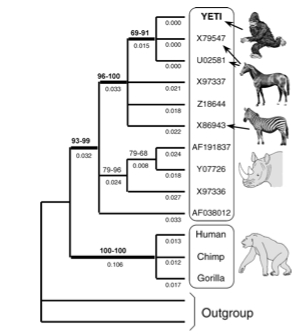Friday Abominable Snowman Molecular Phylogenetics Blogging
The taxonomy of the yeti, the sasquatch, and related fauna has long been a vexed question. The most common position, exemplified by the magisterial work of Sanderson (still in print after forty years!) is that they are primates and probably either apes from some otherwise-extinct genus (e.g., Gigantopithecus), or hominids. The Church of the SubGenius, of course, lays down that SubGenii are, in fact, "Tibetan yetis from Atlantis" (among other things). A more extravagant suggestion was Lovecraft's, that they were mobile, intelligent extraterrestrial fungi, based in this solar system on Yuggoth (traditionally identified by commentators with Pluto, though whether that will survive the recent demotion of that body is unclear). I am happy to report, however, that the taxonomic question has recently been solved, through the power of Science.
- Michel C. Milinkovitch, Aldagisa Caccone, and George Amato, "Molecular phylogenetic analyses indicate extensive morphological convergence between the 'yeti' and primates", Molecular Phylogenetics and Evolution 31 (2004): 1--3 [Free PDF]
- Dave Coltman and Corey Davis, "Molecular cryptozoology meets the Sasquatch ", Trends in Ecology and Evolution 21 (2006): 60--61 [Free PDF]
- Both without abstract.
To quote from the Milinkovitch et al. paper:
In 1992, Peter Matthiessen and photographer Thomas Laird were the first Westerners in over three decades to visit a remote region in the northernmost Himalaya. Located close to the boarder of Tibet, Sao Kohla is a mysterious valley outside of the main city of Lo Monthang. Here Matthiessen, Laird, and their Nepalese colleagues came upon some unusual foot prints in the snow, and were informed by locals that they were the prints of the Mehti (the local name for Yeti). Near a river at the bottom of the gorge, samples of twisted hair were recovered which were clearly identified as Mehti hair by their local guides (Matthiessen, 1995, p. 75--80). We were asked to analyze these samples, but first had to agree that any identification of a "new species" would have to be reported to the government of Nepal before publication.
They sequenced mitochondrial ribosomal RNA from the samples, and constructed a phylogenetic tree, which I reproduce below:

Similarly for Coltman and Davis:
In July 2005, nine residents of Teslin, Yukon, witnessed through a kitchen window a large bipedal animal moving through the brush. The next morning, they collected a tuft of coarse, dark hair and also observed a footprint measuring 43 cm in length and 11.5 cm in width. The tuft of hair was sent to Philip Merchant, a wildlife technician of the Government of Yukon Department of Environment...and so eventually to the authors, who sequenced the DNA. This produced the following tree:

A simple application of the comparative method leads us to conclude that both in western North America and in the Himalayas curious selective pressures have resulted in the convergent evolution of two different groups of ungulates with primates.
In all seriousness, it's not completely implausible that large mammals, even primates, remain undiscovered. As Coltman and Davis note, a new of bovid was described in Vietnam in 1992, and a new species of monkey in Tanzania in 2003, so it's by no means impossible that there is an undescribed primate at large in the Himalayas, or that something rare is shambling around in the Yukon. If you want fodder for speculation, note that Gigantopithecus is known to have survived to about 100,000 years ago, and the ground sloths even more recently than that in the Americas. (Of course, given the degree of armed conflict in and around the Himalayas in recent years, I for one find it only too easy to further imagine the last yetis getting caught in the cross-fire between India and Pakistan, or the Nepalese government and the Maoists.) But, really, every culture I've ever heard of has legends about the roughly human-sized and roughly human-shaped, but not human, creatures who live nearby, and for pretty obvious reasons. I honestly don't see any reason why cryptozoologists should take these stories more seriously when they come from Nepal or the Yukon than when the come from the British Isles.
(Thanks to Danny Yee for alerting me to these papers.)
Manual trackback: Pathologically Polymathic; Chrononautic Log; Untyping; Greg Laden; Gene Expression; MetaFilter; Southeast Sasquatch Association.
Posted at March 09, 2007 16:45 | permanent link